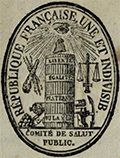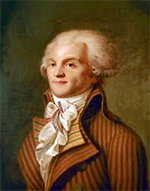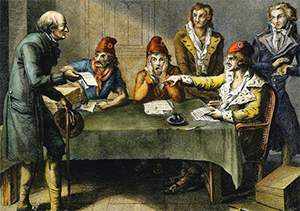The Committee of Public Safety
The National Convention had called for the execution of King Louis XVI and had carried out that sentence in January 1793. The country by then was a constitutional monarchy, but the country then had no monarch, so no executive. The Convention decreed that its various committees would assume the running of the government. One of these was the Committee of Public Safety. 
By this time, despite a handful of victories in late 1792, the war against other European nations was again going badly for France. The Committee of Public Safety spent a large amount of time organizing the country's defense. Indeed, its very existence was due in part to a major defection. Charles Dumouriez, who as foreign minister had negotiated his way into a limited war to begin with and then found his optimistic war plans shattered by reality, defected to Austria, the enemy. The man who had once tried to engineer a pro-France revolt in the Austrian Netherlands had turned completely around and was found to be trying to bring about a plot to seize Paris. Dumouriez defected on April 5, 1793. The Convention created the Committee of Public Safety the next day. The Committee originally had nine members. (Its number grew to 10 and then, finally, to 12.) As conceived, the committee's seats were taken by different people each month, the idea being to stop any one person from gaining too much power. The Committee had the power to appoint not only generals but also, closer to home, judges and even members of juries for the Revolutionary Tribunal. Officially, the Convention could overrule the Committee's decision and even censure its members. In practice, this did not happen. This was particularly significant in that the Committee met in secret and could make decisions without consulting the Convention; all that was required was a weekly report. During its first few weeks, the Committee was a model of revolutionary intent and action, focusing on shoring up the war effort and ensuring that no internal uprisings derailed the country's new path toward egalitarianism. Also during this time, the members of the Committee crossed the political spectrum, involving a mix of moderates and radicals, all of whom had to work together in order to effect the kind of change that they all wanted to see. Leading the way at this time was Georges Danton. 
In time, however, as the country's war fortunes worsened, radicals gained control of the Committee and, still in secret, put themselves more and more in charge of more and more elements of society. Maximilien Robespierre (right) won election to the Committee on July 27, 1793, and maintained his seat until his death. The same was true of other radicals such as Louis Saint-Just and Lazare Carnot. To Bertrand Barére the Committee left the writing of new laws and the reporting (more selectively as time went on) to the National Convention. As more and more radicals controlled actions in the Convention, the Convention itself gave more and more power to the Committee of Public Safety. On Sept. 14, 1793, the Convention handed over to the Committee the power to appoint deputies to other committees. On September 17, the Convention created the Law of Suspects, which greatly expanded the way in which people could be declared targets for arrest and punishment; following that was the Law of the Maximum, which set price ceilings in order to crack down on people engaged in price gouging. These measures concentrated in the Committee more and more power. This expansion of power resulted in more and more executions of so-called enemies of the state, notable among them Queen Marie Antoinette and the Girondin leader Jacques Brissot. On October 10, the Committee declared itself in charge of all of the government except the National Convention, to which the committee still nominally reported once a week. By this time, the leaders of the Committee were Robespierre, Saint-Just, and George Couthon. In reality, they were running the country and directing the Reign of Terror. The Committee's takeover of the government was complete on Dec. 4, 1793, when the Convention passed the Law of 14 Frimaire, or the Law of Revolutionary Government. Also known as the "Constitution of the Terror," this law gave to the Committee supreme executive power. 
One of the main aims of the Reign of Terror was to eliminate enemies of the state. With the December takeover, the Committee had the power to decide who were enemies of the state. Even though Jacques Hébert and his followers had supported the Reign of Terror and, in particular, the Law of Suspects, the Committee declared them outlaws, as it were, and sent Hébert and the other leaders of his movement to the guillotine, in March 1794. This followed a pattern of the Committee's identifying former allies as enemies and then dispatching them. At the same time, the Committee created the General Police Bureau, the members of which reported directly to the Committee. Resenting this action was the Committee of General Security, which was nominally in charge of policing. In June 1794, the Committee created the Law of 22 Prairial, which put a structure around the process of identifying and punishing enemies of the state. Prisoners were denied lawyers, and witness testimony all but disappeared. Monumentally under this law, the punishment for all crimes delineated was death. This dramatically increased the number of deaths. In effect, it was nearly a straight line from arrest to execution. In the 13 months before the passage of this law, the Revolutionary Tribunal had delivered 1,220 death verdicts. In the first 49 days after the passage of this law, the number of executions was 1,376. As the summer of 1794 continued, dissent grew inside the Committee. Robespierre and Saint-Just found themselves increasingly isolated, even though they retained enormous power. Recent military victories had convinced many that the Committee no longer had the country's best interests at heart and was overstepping the bounds of its original purpose, that of defending the country from foreign enemies. Robespierre gave a speech to the National Convention on July 26, 1794, calling for purges within the government's various committees. The next day, Saint-Just rose to speak at the Convention but didn't finish. He found himself at the center of a series of accusations with which he would have been all too familiar. Also targeted was Robespierre. The pair were arrested, along with a handful of their supporters, but not until they had taken refuge in the Hôtel de Ville and started planning an armed rebellion. Their attempt at insurrection failed. The leaders of the Terror were themselves sent to the guillotine, on July 28, 1794. It was the month of Thermidor, according to the Republican Calendar, and the series of related events came to be known as the Thermidorian Reaction. Cooler heads repealed many of the Committee's extreme laws and reduced its power. The Committee itself was legislated out of existence by the Constitution of the Year III, otherwise known as the Constitution of 1795. Also beginning with that governmental blueprint was the National Convention's successor body, the Directory.
|
|
Social Studies for Kids
copyright 2002–2025
David White




